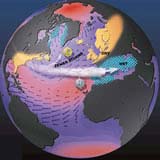Storms lower ozone levels

The North Atlantic Oscillation mixes the surrounding region’s air. © M. Visbeck
Ozone miniholes over the North Atlantic follow the unsteady pulse of climate fluctuations.
Recurring fluctuations in the North Atlantic climate are punching miniholes in the ozone layer, exposing Scandinavia and northern Europe to higher levels of ultraviolet radiation than normal, say two climatologists.
Seesawing air pressure over Greenland and the subtropical north Atlantic Ocean stirs the atmosphere and wafts ozone-depleted air towards populated high-latitude regions in the Northern Hemisphere, they suggest1.
In the winter of 1999 the ozone that usually blankets some areas of the North Atlantic was replaced by a threadbare sheet. The amount of ozone in the atmosphere over southern Scandinavia that December reached a record low.
These temporary but substantial episodes of ozone depletion are called ’miniholes’. They are associated with greater levels of harmful ultraviolet rays at ground level – atmospheric ozone usually filters out this radiation from sunlight.
Ozone depletion and holes normally surround the poles, where chemical reactions involving human-made CFC gases decimate ozone in the upper atmosphere. The North Atlantic’s ozone miniholes aren’t created this way. Natural processes make and destroy atmospheric ozone constantly. The thickness of the ozone layer worldwide depends on how ozone-rich and ozone-poor air gets mixed.
Yvan Orsolini of the Norwegian Institute for Air Research in Kjeller and Varavut Limpasuvan of the Costal Carolina University in Conway, South Carolina, say that a climate phenomenon called the North Atlantic Oscillation (NAO) dominates the mixing of air in the North Atlantic region.
The NAO is responsible for much of the region’s monthly and yearly variations in climate, much as the El Nino/Southern Oscillation influences the climates of many tropical and mid-latitude regions in the Southern Hemisphere.
The NAO tips between two phases. In its positive phase, there is a pronounced low-pressure region over Iceland, and high pressure over the subtropical Atlantic (around the Azores and the coast of Portugal). In the negative phase, the Icelandic low and the subtropical high are much weaker. These two phases switch every year or so, bringing changes in weather and temperatures over Europe and Scandinavia.
The NAO also controls how air circulates in the North Atlantic, which led Orsolini and Limpasuvan to suspect that it might influence the appearance of ozone miniholes. In the positive phase, a jet of air from North America swoops northeastwards across the North Atlantic and Scandinavia, bringing storms. In the negative phase a weaker jet carries moist air from America to the Mediterranean region.
Ozone variability and miniholes tend to appear along storm tracks over the North Atlantic. Orsolini and Limpasuvan compared 20 years of satellite ozone measurements with measurements of the phase and strength of the NAO.
They found that dips in ozone match up with times when storms cross the Atlantic into Scandinavia and northern Europe. The researchers reason that the transatlantic jet during this phase brings ozone-poor air from the lower atmosphere of the subtropical United States to the base of the upper atmosphere in northern Europe and Scandinavia, diluting the ozone layer here.
They point out that pronounced ’positive-phase’ NAO events have been more common since the 1980s and 1990s, and that these are probably responsible for the increasing incidence of ozone miniholes.
References
- Orsolini, Y. J. & Limpasuvan, V. The North Atlantic Oscillation and the occurrences of ozone miniholes. Geophysical Research Letters, 20, 4099 – 4102, (2001).
Media Contact
All latest news from the category: Earth Sciences
Earth Sciences (also referred to as Geosciences), which deals with basic issues surrounding our planet, plays a vital role in the area of energy and raw materials supply.
Earth Sciences comprises subjects such as geology, geography, geological informatics, paleontology, mineralogy, petrography, crystallography, geophysics, geodesy, glaciology, cartography, photogrammetry, meteorology and seismology, early-warning systems, earthquake research and polar research.
Newest articles
Faster, more energy-efficient way to manufacture an industrially important chemical
Zirconium combined with silicon nitride enhances the conversion of propane — present in natural gas — needed to create in-demand plastic, polypropylene. Polypropylene is a common type of plastic found…

Energy planning in Ghana as a role model for the world
Improving the resilience of energy systems in the Global South. What criteria should we use to better plan for resilient energy systems? How do socio-economic, technical and climate change related…

Artificial blood vessels could improve heart bypass outcomes
Artificial blood vessels could improve heart bypass outcomes. 3D-printed blood vessels, which closely mimic the properties of human veins, could transform the treatment of cardiovascular diseases. Strong, flexible, gel-like tubes…





















